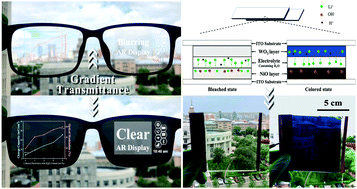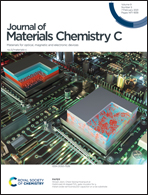A large-area, flexible, high contrast and long-life stable solid-state electrochromic device driven by an anion-assisted method†
Abstract
Electrochromic (EC) smart windows regulate the indoor solar radiation by adjusting the optical transmittance, offering an efficient solution toward energy-saving buildings. Tungsten oxide/nickel oxide (WO3/NiO) solid-state devices are most likely to be industrialized among all the electrochromic devices (ECDs). However, there are still some problems in WO3/NiO-based solid-state electrochromic devices (ECDs), such as inflexibility, low visible light contrast, slow response speed, and poor stability in the switching process due to the charge capacity mismatch of WO3 and NiO layers. Moreover, the whole charge capacity of the ECDs depends on the charge capacity of NiO layers, which is extremely less than that of WO3 layers. Therefore, high charge capacity NiO films are in urgent demand for the fabrication of high-performance WO3/NiO solid-state ECDs with long-life stability. In order to improve these properties and overcome the mismatch problem with WO3, 2–8 wt% of H2O is added to the lithium electrolyte, which can provide hydroxide ions to participate in the electrochromic reaction of NiO films. Thus, high charge capacity (7 times enhanced than that in the anhydrous electrolyte) and high optical modulation (59.5% at 511 nm) of NiO films can be obtained. More importantly, due to the low content, OH− can be fixed on the NiO films as NiOOH, which will not erode WO3 films in devices. Hence, solid-state electrochromic devices with the structure of ITO/WO3/electrolyte/NiO/ITO were assembled, exhibiting excellent optical modulation of 62% and long-life stability up to 10 000 cycles without attenuation. Furthermore, flexible and large-area devices can also be obtained, which is important for a wide range of scientific and industrial processes.



 Please wait while we load your content...
Please wait while we load your content...